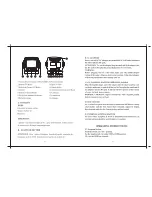
4
IMPORTANT SAFETY INSTRUCTIONS
For power outages, permanently installed
stationary generators are better suited for providing
back-up power to the home. Even a properly
connected portable generator can become
overloaded. This may result in overheating or
stressing the generator components, possibly
leading to generator failure.
Inspect the unit before each use for loose
fasteners, fuel leaks, etc. Replace damaged parts.
Use only recommended or equivalent replacement
parts and accessories. Use of any other parts or
failure to follow maintenance instructions may
create a risk of shock or injury.
FUEL FILLING SAFETY RULES
DANGER: RISK OF FIRE AND
SERIOUS BURNS.
Never remove fuel
cap when unit is running. Shut off engine
and allow the unit to cool at least five minutes.
Remove cap slowly.
WARNING:
Select bare ground for
fuelling and move at least 10 feet (3m)
from fuelling spot before starting the
engine.After refuelling, properly tighten fuel cap;
wipe off any spilled fuel and check for leakage.
WARNING:
If fuel gets spilled on clothes,
especially trousers, it is very important to
change clothes immediately. Do not rely
on evaporation. Flammable quantities of fuel may
remain on clothes after a spill for longer than
expected.
WARNING:
Vibrations can cause an
improperly tightened fuel cap to loosen
or come off and spill quantities of fuel. In
order to reduce the risk of fuel spillage and fire,
tighten fuel filler cap by hand as securely as
possible. Before use always make sure that the
fuel cap has been properly tightened. Check for
fuel leakage while refuelling and during operation.
If a fuel leak is suspected, do not start or run the
engine until leak is fixed and spilled fuel has been
wiped away.
ADDING OR REMOVING FUEL
Turn the generator off and let it cool for at least five
minutes before removing the fuel cap. Loosen the
cap slowly to relieve pressure in the tank.
Only fill or drain fuel outdoors in a well-ventilated
area.
DO NOT pump gasoline directly into the generator
at the gasoline station. Use an approved container
to transfer the fuel to the generator.
DO NOT overfill the fuel tank.
Always keep fuel away from sparks, open flames,
pilot lights, heat and other sources of ignition.
DO NOT light or smoke cigarettes.
WHEN STARTING THE GENERATOR
DO NOT attempt to start a damaged generator.
Make certain that the gas cap, air filter, spark plug,
fuel lines and exhaust system are properly in place.
Allow spilled fuel to evaporate fully before
attempting to start the engine.
Make certain that the generator is resting firmly on
level ground.
WHEN OPERATING THE GENERATOR
DO NOT move or tip the generator during
operation.
DO NOT tip the generator or allow fuel or oil to
spill.
WHEN TRANSPORTING OR SERVICING THE
GENERATOR
Make certain that the fuel shutoff valve is in the off
position and the fuel tank is empty.
Disconnect the spark plug wire.
When storing the generator:
Store away from sparks, open flames, pilot lights,
heat and other sources of ignition.





































